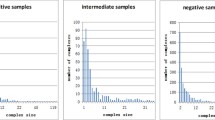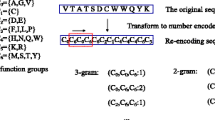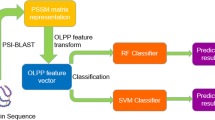Abstract
Protein–protein interaction plays an important role in the understanding of biological processes in the body. A network of dynamic protein complexes within a cell that regulates most biological processes is known as a protein–protein interaction network (PPIN). Complex prediction from PPINs is a challenging task. Most of the previous computation approaches mine cliques, stars, linear and hybrid structures as complexes from PPINs by considering topological features and fewer of them focus on important biological information contained within protein amino acid sequence. In this study, we have computed a wide variety of topological features and integrate them with biological features computed from protein amino acid sequence such as bag of words, physicochemical and spectral domain features. We propose a new Sequential Forward Feature Selection (SFFS) algorithm, i.e., random forest-based Boruta feature selection for selecting the best features from computed large feature set. Decision tree, linear discriminant analysis and gradient boosting classifiers are used as learners. We have conducted experiments by considering two reference protein complex datasets of yeast, i.e., CYC2008 and MIPS. Human and mouse complex information is taken from CORUM 3.0 dataset. Protein interaction information is extracted from the database of interacting proteins (DIP). Our proposed SFFS, i.e., random forest-based Brouta feature selection in combination with decision trees, linear discriminant analysis and Gradient Boosting Classifiers outperforms other state of art algorithms by achieving precision, recall and F-measure rates, i.e. 94.58%, 94.92% and 94.45% for MIPS, 96.31%, 93.55% and 96.02% for CYC2008, 98.84%, 98.00%, 98.87 % for CORUM humans and 96.60%, 96.70%, 96.32% for CORUM mouse dataset complexes, respectively.








Similar content being viewed by others
References
Peng Y, Lu Z (2017) Deep learning for extracting protein-protein interactions from biomedical literature, pp 29–38. https://doi.org/10.18653/v1/w17-2304
Qi Y, Balem F, Faloutsos C, Klein-Seetharaman J, Bar-Joseph Z (2008) Protein complex identification by supervised graph local clustering. Bioinformatics. https://doi.org/10.1093/bioinformatics/btn164
Smits AH, Vermeulen M (2016) Characterizing protein-protein interactions using mass spectrometry: challenges and opportunities. Trends Biotechnol 34(10):825–834. https://doi.org/10.1016/j.tibtech.2016.02.014
Celaj A et al (2017) Quantitative analysis of protein interaction network dynamics in yeast. Mol Syst Biol 13(7):934. https://doi.org/10.15252/msb.20177532
Brückner A, Polge C, Lentze N, Auerbach D, Schlattner U (2009) Yeast two-hybrid, a powerful tool for systems biology. Int J Mol Sci 10(6):2763–2788. https://doi.org/10.3390/ijms10062763
Puig O et al (2001) The tandem affinity purification (TAP) method: a general procedure of protein complex purification. Methods 24(3):218–229. https://doi.org/10.1006/meth.2001.1183
George PM, Mlynash M, Adams CM, Kuo CJ, Albers GW, Olivot J-M (2015) Novel Tia biomarkers identified by mass spectrometry-based proteomics. Int J Stroke 10(8):1204–1211. https://doi.org/10.1111/ijs.12603
Templin MF, Stoll D, Schrenk M, Traub PC, Vöhringer CF, Joos TO (2002) Protein microarray technology. Drug Discov Today 7(15):815–822. https://doi.org/10.1016/S1359-6446(00)01910-2
Sidhu SS, Koide S (2007) Phage display for engineering and analyzing protein interaction interfaces. Curr Opin Struct Biol 17(4):481–487. https://doi.org/10.1016/j.sbi.2007.08.007
Shoemaker BA, Panchenko AR (2007) Deciphering protein-protein interactions. Part I. Experimental techniques and databases. PLoS Comput Biol 3(3):e42. https://doi.org/10.1371/journal.pcbi.0030042
Oughtred R et al (2019) The BioGRID interaction database: 2019 update. Nucleic Acids Res 47(D1):D529–D541. https://doi.org/10.1093/nar/gky1079
Xenarios I (2002) DIP, the Database of Interacting Proteins: a research tool for studying cellular networks of protein interactions. Nucleic Acids Res 30(1):303–305. https://doi.org/10.1093/nar/30.1.303
Giurgiu M et al (2019) CORUM: the comprehensive resource of mammalian protein complexes—2019. Nucleic Acids Res 47(D1):D559–D563. https://doi.org/10.1093/nar/gky973
Pagel P et al (2005) The MIPS mammalian protein-protein interaction database. Bioinformatics 21(6):832–834. https://doi.org/10.1093/bioinformatics/bti115
Pu S, Wong J, Turner B, Cho E, Wodak SJ (2009) Up-to-date catalogues of yeast protein complexes. Nucleic Acids Res 37(3):825–831. https://doi.org/10.1093/nar/gkn1005
Licata L et al (2012) MINT, the molecular interaction database: 2012 Update. Nucleic Acids Res. https://doi.org/10.1093/nar/gkr930
Kanehisa M, Furumichi M, Tanabe M, Sato Y, Morishima K (2017) KEGG: new perspectives on genomes, pathways, diseases and drugs. Nucleic Acids Res 45(D1):D353–D361. https://doi.org/10.1093/nar/gkw1092
Szklarczyk D et al (2019) STRING v11: protein-protein association networks with increased coverage, supporting functional discovery in genome-wide experimental datasets. Nucleic Acids Res 47(D1):D607–D613. https://doi.org/10.1093/nar/gky1131
Bateman A et al (2017) UniProt: the universal protein knowledgebase. Nucleic Acids Res 45(D1):D158–D169. https://doi.org/10.1093/nar/gkw1099
Haw R, Loney F, Ong E, He Y, Wu G (2020) Perform Pathway Enrichment Analysis Using ReactomeFIViz. Humana, New York, pp 165–179. https://doi.org/10.1007/978-1-4939-9873-9_13
Bader GD, Hogue CWV (2003) An automated method for finding molecular complexes in large protein interaction networks. BMC Bioinform. https://doi.org/10.1186/1471-2105-4-2
Adamcsek B, Palla G, Farkas IJ, Derényi I, Vicsek T (2006) CFinder: locating cliques and overlap** modules in biological networks. Bioinformatics 22(8):1021–1023. https://doi.org/10.1093/bioinformatics/btl039
Wu M, Li X, Kwoh C-K, Ng S-K (2009) A core-attachment based method to detect protein complexes in PPI networks. BMC Bioinform 10(1):169. https://doi.org/10.1186/1471-2105-10-169
Li M, Chen J, Wang J, Hu B, Chen G (2008) Modifying the DPClus algorithm for identifying protein complexes based on new topological structures. BMC Bioinform 9(1):398. https://doi.org/10.1186/1471-2105-9-398
Leung HCM, **ang Q, Yiu SM, Chin FYL (2009) Predicting protein complexes from PPI data: a core-attachment approach. J Comput Biol 16(2):133–144. https://doi.org/10.1089/cmb.2008.01TT
Dong Y, Sun Y, Qin C (2018) Predicting protein complexes using a supervised learning method combined with local structural information. PLoS One 13(3):e0194124. https://doi.org/10.1371/journal.pone.0194124
Yu Y, Lin L, Sun C, Wang X, Wang X (2011) Complex detection based on integrated properties. In: Lecture notes in computer science (including subseries lecture notes in artificial intelligence and lecture notes in bioinformatics), vol. 7062 LNCS, no. PART 1:121–128. https://doi.org/10.1007/978-3-642-24955-6_15
Mewes HW et al (2008) MIPS: analysis and annotation of genome information in 2007. Nucleic Acids Res 36(SUPPL):1. https://doi.org/10.1093/nar/gkm980
Liu Q, Song J, Li J (2016) Using contrast patterns between true complexes and random subgraphs in PPI networks to predict unknown protein complexes. Sci Rep. https://doi.org/10.1038/srep21223
Zeng J, Li D, Wu Y, Zou Q, Liu X (2015) An empirical study of features fusion techniques for protein-protein interaction prediction. Curr Bioinform 11(1):4–12. https://doi.org/10.2174/1574893611666151119221435
Khan J, Bhatti MH, Khan UG, Iqbal R (2019) Multiclass EEG motor-imagery classification with sub-band common spatial patterns. Eurasip J Wirel Commun Netw 2019(1):1–9. https://doi.org/10.1186/s13638-019-1497-y
Bhatti MH et al (2019) Soft computing-based EEG classification by optimal feature selection and neural networks. IEEE Trans Ind Inform 15(10):5747–5754. https://doi.org/10.1109/TII.2019.2925624
Ahmad F, Farooq A, Ghani Khan MU, Shabbir MZ, Rabbani M, Hussain I (2020) Identification of most relevant features for classification of Francisella tularensis using machine learning. Curr Bioinform. https://doi.org/10.2174/1574893615666200219113900
Zou Q, Zeng J, Cao L, Ji R (2016) A novel features ranking metric with application to scalable visual and bioinformatics data classification. Neurocomputing 173:346–354. https://doi.org/10.1016/j.neucom.2014.12.123
Zhang SW, Cheng YM, Luo L, Pan Q (2011) Prediction of protein-protein interaction using distance frequency of amino acids grouped with their physicochemical properties. In: Proceedings—2011 6th International conference on bio-inspired computing: theories and applications, BIC-TA 2011, pp 70–74, https://doi.org/10.1109/BIC-TA.2011.53
Jolliffe I (2011) Principal component analysis. International encyclopedia of statistical science. Springer, Berlin, pp 1094–1096. https://doi.org/10.1007/978-3-642-04898-2_455
Sikandar A et al (2018) Decision tree based approaches for detecting protein complex in protein protein interaction network (PPI) via link and sequence analysis. IEEE Access 6:22108–22120. https://doi.org/10.1109/ACCESS.2018.2807811
Sikandar A, Anwar W, Sikandar M (2019) Combining sequence entropy and subgraph topology for complex prediction in protein protein interaction (PPI) network. Curr Bioinform 14(6):516–523. https://doi.org/10.2174/1574893614666190103100026
Faridoon A, Sikandar A, Imran M, Ghouri S, Sikandar M, Sikandar W (2020) Combining SVM and ECOC for identification of protein complexes from protein protein interaction networks by integrating amino acids’ physical properties and complex topology. Interdiscip Sci Comput Life Sci. https://doi.org/10.1007/s12539-020-00369-5
Kursa MB, Jankowski A, Rudnicki WR (2010) Boruta - a system for feature selection. Fundam Informaticae 101(4):271–285. https://doi.org/10.3233/FI-2010-288
Gursoy A, Keskin O, Nussinov R (2008) Topological properties of protein interaction networks from a structural perspective. Biochem Soc Trans 36(Pt 6):1398–403. https://doi.org/10.1042/BST0361398
Guo Y-Z et al (2006) Classifying G protein-coupled receptors and nuclear receptors on the basis of protein power spectrum from fast Fourier transform. Amino Acids 30(4):397–402. https://doi.org/10.1007/s00726-006-0332-z
Jolliffe I (2005) Principal component analysis, in encyclopedia of statistics in behavioral science. Wiley, Chichester. https://doi.org/10.1002/0470013192.bsa501
Bérard A, Servan C, Pietquin O, Besacier L (2016) MultiVec: a multilingual and multilevel representation learning toolkit for NLP. https://hal.archives-ouvertes.fr/hal-01335930/. Accessed 16 Jun 2019
Singh P (2019) Natural language processing, in machine learning with PySpark. Apress, Berkeley, pp 191–218
Kulkarni A, Shivananda A (2019) Converting text to features. Natural language processing recipes. Apress, Berkeley, pp 67–96
Li Z-W, You Z-H, Chen X, Gui J, Nie R (2016) Highly accurate prediction of protein-protein interactions via incorporating evolutionary information and physicochemical characteristics. Int J Mol Sci. https://doi.org/10.3390/ijms17091396
Kawashima S, Pokarowski P, Pokarowska M, Kolinski A, Katayama T, Kanehisa M (2008) AAindex: amino acid index database, progress report 2008. Nucleic Acids Res 36(Database issue):D202–5. https://doi.org/10.1093/nar/gkm998
Nakai K, Kidera A, Kanehisa M (2019) Cluster analysis of amino acid indices for prediction of protein structure and function. Protein Eng 2(2):93–100. https://doi.org/10.1093/protein/2.2.93
Kawashima S, Kanehisa M (2000) AAindex: amino acid index database. Nucleic Acids Res 28(1):374. https://doi.org/10.1093/nar/28.1.374
Tomii K, Kanehisa M (1996) Analysis of amino acid indices and mutation matrices for sequence comparison and structure prediction of proteins. Protein Eng 9(1):27–36. https://doi.org/10.1093/protein/9.1.27
Raicar G, Saini H, Dehzangi A, Lal S, Sharma A (2016) Improving protein fold recognition and structural class prediction accuracies using physicochemical properties of amino acids. J Theor Biol 402:117–128. https://doi.org/10.1016/J.JTBI.2016.05.002
Blei DM, Ng AY, Jordan MI (2019) Blei03a.Pdf. J Mach Learn Res 3:993–1022. http://www.jmlr.org/papers/volume3/blei03a/blei03a.pdf. Accessed 11 Nov 2003
Tagami H, Ray-Gallet D, Almouzni G, Nakatani Y (2004) Histone H3.1 and H3.3 complexes mediate nucleosome assembly pathways dependent or independent of DNA synthesis. Cell 116(1):51–61. https://doi.org/10.1016/S0092-8674(03)01064-X
Poss ZC, Ebmeier CC, Taatjes DJ (2013) The mediator complex and transcription regulation. Crit Rev Biochem Mol Biol 48(6):575–608. https://doi.org/10.3109/10409238.2013.840259
Soutourina J (2018) Transcription regulation by the Mediator complex. Nat Rev Mol Cell Biol 19(4):262–274. https://doi.org/10.1038/nrm.2017.115
Lucas X, Ciulli A (2017) Recognition of substrate degrons by E3 ubiquitin ligases and modulation by small-molecule mimicry strategies. Curr Opin Struct Biol 44:101–110. https://doi.org/10.1016/j.sbi.2016.12.015
Rodriguez P et al (2005) GATA-1 forms distinct activating and repressive complexes in erythroid cells. EMBO J 24(13):2354–2366. https://doi.org/10.1038/sj.emboj.7600702
Bottardi S et al (2014) The IKAROS interaction with a complex including chromatin remodeling and transcription elongation activities is required for hematopoiesis. PLoS Genet 10(12):e1004827. https://doi.org/10.1371/journal.pgen.1004827
Bottardi S, Mavoungou L, Milot E (2015) IKAROS: a multifunctional regulator of the polymerase II transcription cycle. Trends Genet 31(9):500–508. https://doi.org/10.1016/j.tig.2015.05.003
Sikandar M et al (2020) Analysis for disease gene association using machine learning. IEEE Access 8:160616–160626. https://doi.org/10.1109/ACCESS.2020.3020592
Author information
Authors and Affiliations
Corresponding author
Ethics declarations
Conflict of interest
The authors declare that they have no conflict of interest.
Rights and permissions
About this article
Cite this article
Younis, H., Anwar, M.W., Khan, M.U.G. et al. A New Sequential Forward Feature Selection (SFFS) Algorithm for Mining Best Topological and Biological Features to Predict Protein Complexes from Protein–Protein Interaction Networks (PPINs). Interdiscip Sci Comput Life Sci 13, 371–388 (2021). https://doi.org/10.1007/s12539-021-00433-8
Received:
Revised:
Accepted:
Published:
Issue Date:
DOI: https://doi.org/10.1007/s12539-021-00433-8




